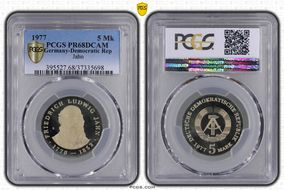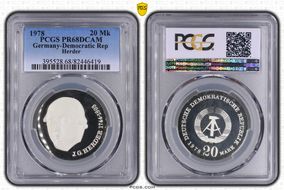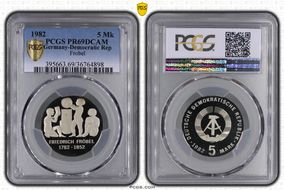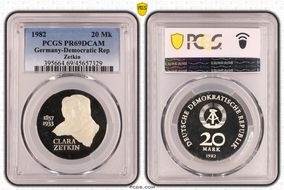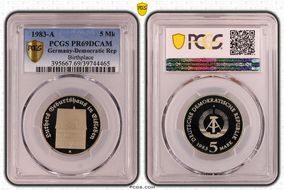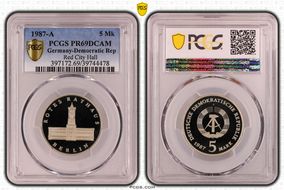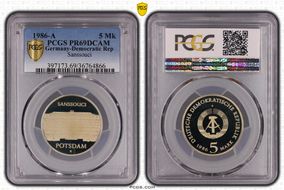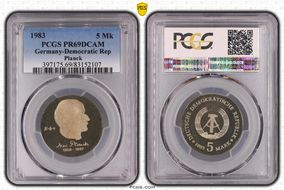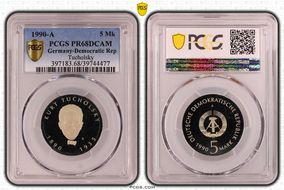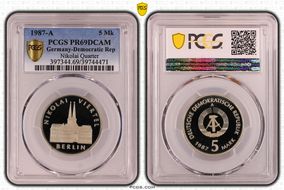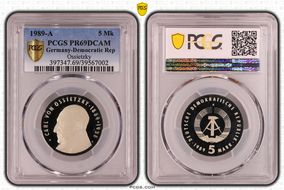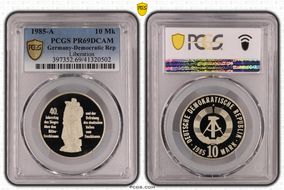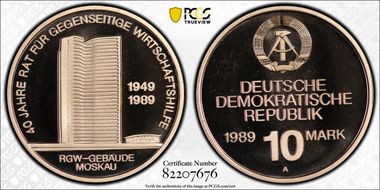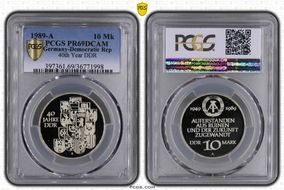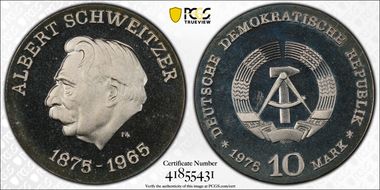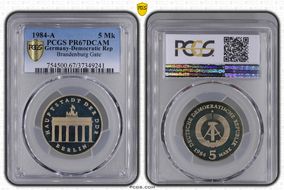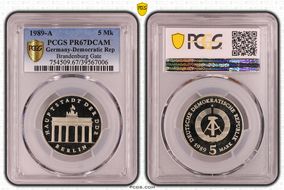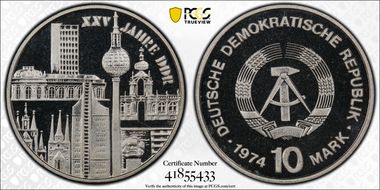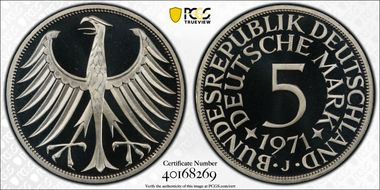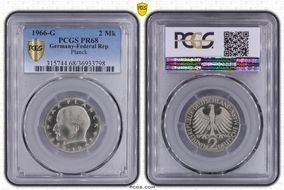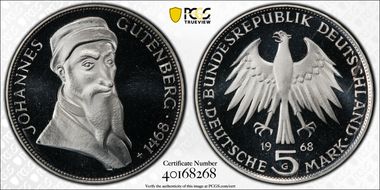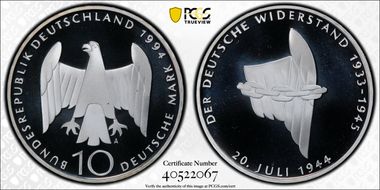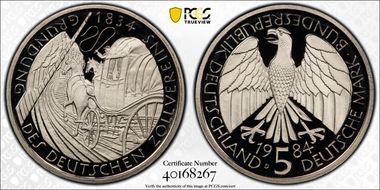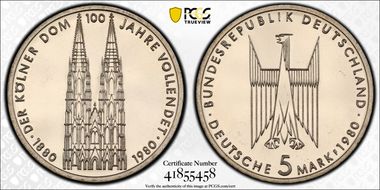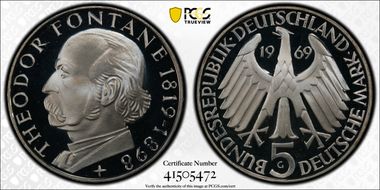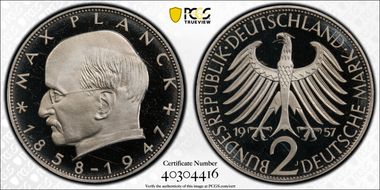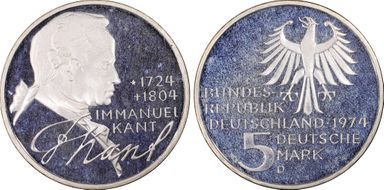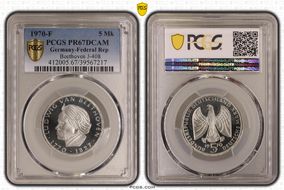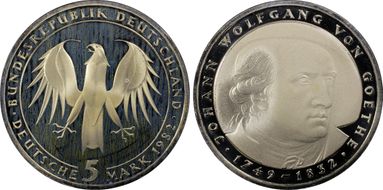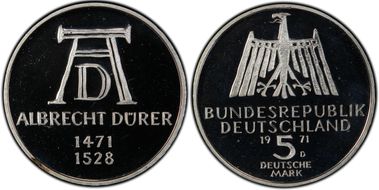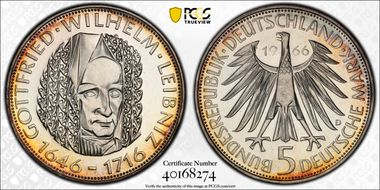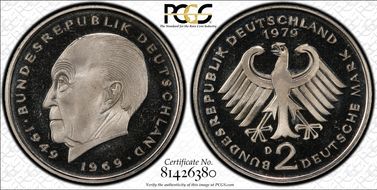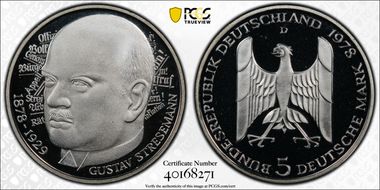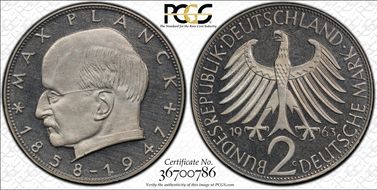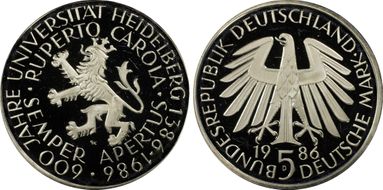Ascalor 的钱币相册
Germany-Democratic Republic | KM# 127 | J-1624 | Commemorating the 500th birthday of Thomas Muentzner Thomas Müntzer (c. 1489 – 27 May 1525) was a German preacher and radical theologian of the early Reformation whose opposition to both Martin Luther and the Roman Catholic Church led to his open defiance of late-feudal authority in central Germany. Müntzer was foremost amongst those reformers who took issue with Luther's compromises with feudal authority. He became a leader of the German peasant and plebeian uprising of 1525 commonly known as the German Peasants' War. He was captured after the Battle of Frankenhausen, tortured and executed.
Germany-Democratic Republic | KM# 53 | J-1549 | Commemorating the 250th birthday of Immanuel Kant. Immanuel Kant (22 April 1724 – 12 February 1804) was an influential German philosopher in the Age of Enlightenment. In his doctrine of transcendental idealism, he argued that space, time, and causation are mere sensibilities; "things-in-themselves" exist, but their nature is unknowable. In his view, the mind shapes and structures experience, with all human experience sharing certain structural features. In one of his major works, the Critique of Pure Reason (1781; second edition 1787), he drew a parallel to the Copernican revolution in his proposition that worldly objects can be intuited a priori ('beforehand'), and that intuition is therefore independent from objective reality.
Germany-Democratic Republic | KM# 64 | J-1564 | Commemorating the 125th obit of Friedrich Ludwig Jahn Friedrich Ludwig Jahn (11 August 1778 – 15 October 1852) was a German gymnastics educator and nationalist whose writing is credited with the founding of the German gymnastics (Turner) movement as well as influencing the German Campaign of 1813, during which a coalition of German states effectively ended the occupation of Napoleon's First French Empire. His admirers know him as Turnvater Jahn, roughly meaning "father of gymnastics" Jahn.
Germany-Democratic Republic | KM# 64 | J-1564 | Commemorating the 125th obit of Friedrich Ludwig Jahn Friedrich Ludwig Jahn (11 August 1778 – 15 October 1852) was a German gymnastics educator and nationalist whose writing is credited with the founding of the German gymnastics (Turner) movement as well as influencing the German Campaign of 1813, during which a coalition of German states effectively ended the occupation of Napoleon's First French Empire. His admirers know him as Turnvater Jahn, roughly meaning "father of gymnastics" Jahn.
KM# 71 | J-1570 | Commemorating the 175th obit of Johann Gottfried von Herder Johann Gottfried (after 1802, von) Herder (25 August 1744 – 18 December 1803) was a German philosopher, theologian, poet, and literary critic. He is associated with the Enlightenment, Sturm und Drang, and Weimar Classicism.
KM# 71 | J-1570 | Commemorating the 175th obit of Johann Gottfried von Herder Johann Gottfried (after 1802, von) Herder (25 August 1744 – 18 December 1803) was a German philosopher, theologian, poet, and literary critic. He is associated with the Enlightenment, Sturm und Drang, and Weimar Classicism.
Germany-Democratic Republic | KM# 78 | J-1575 | Commemorating the 75th obit of Ernst Abbe Ernst Karl Abbe (23 January 1840 – 14 January 1905) was a German physicist, optical scientist, entrepreneur, and social reformer. Together with Otto Schott and Carl Zeiss, he developed numerous optical instruments. He was also a co-owner of Carl Zeiss AG, a German manufacturer of scientific microscopes, astronomical telescopes, planetariums, and other advanced optical systems.
Germany-Democratic Republic | KM# 81 | J-1581 | Commemorating the 150th obit of Georg Wilhelm Friedrich Hegel Georg Wilhelm Friedrich Hegel (/ˈheɪɡəl/; German: [ˈɡeːɔʁk ˈvɪlhɛlm ˈfʁiːdʁɪç ˈheːɡl̩]; 27 August 1770 – 14 November 1831) was a German philosopher and the most important figure in German idealism. He is considered one of the fundamental figures of modern Western philosophy, with his influence extending to the entire range of contemporary philosophical issues, from aesthetics to ontology to politics, both in the analytic and continental tradition.
Germany-Democratic Republic | KM# 81 | J-1581 | Commemorating the 150th obit of Georg Wilhelm Friedrich Hegel Georg Wilhelm Friedrich Hegel (/ˈheɪɡəl/; German: [ˈɡeːɔʁk ˈvɪlhɛlm ˈfʁiːdʁɪç ˈheːɡl̩]; 27 August 1770 – 14 November 1831) was a German philosopher and the most important figure in German idealism. He is considered one of the fundamental figures of modern Western philosophy, with his influence extending to the entire range of contemporary philosophical issues, from aesthetics to ontology to politics, both in the analytic and continental tradition.
Germany-Democratic Republic | KM# 107 | J-1606 | Commemorating the 175th anniversary of the Humboldt University of Berlin Humboldt University of Berlin (German: Humboldt-Universität zu Berlin, abbreviated HU Berlin) is a public research university in the central borough of Mitte in Berlin, Germany. It was established by Frederick William III on the initiative of Wilhelm von Humboldt, Johann Gottlieb Fichte and Friedrich Ernst Daniel Schleiermacher as the University of Berlin (Universität zu Berlin) in 1809, and opened in 1810, making it the oldest of Berlin's four universities. From 1810 until its closure in 1945, it was named Friedrich Wilhelm University (German: Friedrich-Wilhelms-Universität). During the Cold War the university found itself in East Berlin and was de facto split in two when the Free University of Berlin opened in West Berlin. The university received its current name in honour of Alexander and Wilhelm von Humboldt in 1949.
Germany-Democratic Republic | KM# 107 | J-1606 | Commemorating the 175th anniversary of the Humboldt University of Berlin Humboldt University of Berlin (German: Humboldt-Universität zu Berlin, abbreviated HU Berlin) is a public research university in the central borough of Mitte in Berlin, Germany. It was established by Frederick William III on the initiative of Wilhelm von Humboldt, Johann Gottlieb Fichte and Friedrich Ernst Daniel Schleiermacher as the University of Berlin (Universität zu Berlin) in 1809, and opened in 1810, making it the oldest of Berlin's four universities. From 1810 until its closure in 1945, it was named Friedrich Wilhelm University (German: Friedrich-Wilhelms-Universität). During the Cold War the university found itself in East Berlin and was de facto split in two when the Free University of Berlin opened in West Berlin. The university received its current name in honour of Alexander and Wilhelm von Humboldt in 1949.
Germany-Democratic Republic | KM# 82 | J-1582 | Commemorating the 700th anniversary of the Berlin mint The Staatliche Münze Berlin (SMB) is a European coin mint located in the city of Berlin. It is one of the four German coin mints, the most prominent of the others being the SMBW which, on 1 January 2014 was authorised to mint coins for the Latvian government. All coins from the SMB contain an 'A' mark for tracking purposes. The SMB has been in operation since 1750 during the era of Frederick the Great.
Germany-Democratic Republic | KM# 84 | J-1584 | Commemorating the 200th birthday of Friedrich Wilhelm August Fröbel Friedrich Wilhelm August Fröbel or Froebel (German: [ˈfʁiːdʁɪç ˈvɪlhɛlm ˈʔaʊɡʊst ˈfʁøːbl̩] (About this soundlisten); 21 April 1782 – 21 June 1852) was a German pedagogue, a student of Johann Heinrich Pestalozzi, who laid the foundation for modern education based on the recognition that children have unique needs and capabilities. He created the concept of the kindergarten and coined the word, which soon entered the English language as well. He also developed the educational toys known as Froebel gifts.
Germany-Democratic Republic | KM# 84 | J-1584 | Commemorating the 200th birthday of Friedrich Wilhelm August Fröbel Friedrich Wilhelm August Fröbel or Froebel (German: [ˈfʁiːdʁɪç ˈvɪlhɛlm ˈʔaʊɡʊst ˈfʁøːbl̩] (About this soundlisten); 21 April 1782 – 21 June 1852) was a German pedagogue, a student of Johann Heinrich Pestalozzi, who laid the foundation for modern education based on the recognition that children have unique needs and capabilities. He created the concept of the kindergarten and coined the word, which soon entered the English language as well. He also developed the educational toys known as Froebel gifts.
Germany-Democratic Republic | KM# 95 | J-1592 | Commemorating the 100th obit of Karl Marx. Karl Heinrich Marx (5 May 1818 – 14 March 1883) was a German philosopher, economist, historian, sociologist, political theorist, journalist and socialist revolutionary. Born in Trier, Germany, Marx studied law and philosophy at university. He married Jenny von Westphalen in 1843. Due to his political publications, Marx became stateless and lived in exile with his wife and children in London for decades, where he continued to develop his thought in collaboration with German thinker Friedrich Engels and publish his writings, researching in the reading room of the British Museum. His best-known titles are the 1848 pamphlet, The Communist Manifesto, and the three-volume Das Kapital (1867–1883). His political and philosophical thought had enormous influence on subsequent intellectual, economic and political history, and his name has been used as an adjective, a noun and a school of social theory. Marx's critical theories about society, economics and politics – collectively understood as Marxism – hold that human societies develop through class conflict. In capitalism, this manifests itself in the conflict between the ruling classes (known as the bourgeoisie) that control the means of production and the working classes (known as the proletariat) that enable these means by selling their labour power in return for wages. Employing a critical approach known as historical materialism, Marx predicted that, like previous socio-economic systems, capitalism produced internal tensions which would lead to its self-destruction and replacement by a new system known as socialism. For Marx, class antagonisms under capitalism, owing in part to its instability and crisis-prone nature, would eventuate the working class' development of class consciousness, leading to their conquest of political power and eventually the establishment of a classless, communist society constituted by a free association of producers.[14] Marx actively pressed for its implementation, arguing that the working class should carry out organised revolutionary action to topple capitalism and bring about socio-economic emancipation.[15] Marx has been described as one of the most influential figures in human history, and his work has been both lauded and criticised. His work in economics laid the basis for much of the current understanding of labour and its relation to capital, and subsequent economic thought. Many intellectuals, labour unions, artists and political parties worldwide have been influenced by Marx's work, with many modifying or adapting his ideas. Marx is typically cited as one of the principal architects of modern social science.
Germany-Democratic Republic | KM# 90 | J-1590 | Martin Luther's birthplace Martin Luther, O.S.A. (/ˈluːθər/; German: [ˈmaʁtiːn ˈlʊtɐ] (About this soundlisten); 10 November 1483 – 18 February 1546) was a German professor of theology, priest, author, composer, Augustinian monk, and a seminal figure in the Reformation. Luther was ordained to the priesthood in 1507. He came to reject several teachings and practices of the Roman Catholic Church; in particular, he disputed the view on indulgences. Luther proposed an academic discussion of the practice and efficacy of indulgences in his Ninety-five Theses of 1517. His refusal to renounce all of his writings at the demand of Pope Leo X in 1520 and the Holy Roman Emperor Charles V at the Diet of Worms in 1521 resulted in his excommunication by the pope and condemnation as an outlaw by the Holy Roman Emperor.
Germany-Democratic Republic | KM# 90 | J-1590 | Martin Luther's birthplace Martin Luther, O.S.A. (/ˈluːθər/; German: [ˈmaʁtiːn ˈlʊtɐ] (About this soundlisten); 10 November 1483 – 18 February 1546) was a German professor of theology, priest, author, composer, Augustinian monk, and a seminal figure in the Reformation. Luther was ordained to the priesthood in 1507. He came to reject several teachings and practices of the Roman Catholic Church; in particular, he disputed the view on indulgences. Luther proposed an academic discussion of the practice and efficacy of indulgences in his Ninety-five Theses of 1517. His refusal to renounce all of his writings at the demand of Pope Leo X in 1520 and the Holy Roman Emperor Charles V at the Diet of Worms in 1521 resulted in his excommunication by the pope and condemnation as an outlaw by the Holy Roman Emperor.
Germany-Democratic Republic | KM# 115 | J- 1614 | Red City Hall in Berlin The Rotes Rathaus (German: [ˈʁoːtəs ˈʁaːtˌhaʊs], Red City Hall) is the town hall of Berlin, located in the Mitte district on Rathausstraße near Alexanderplatz. It is the home to the governing mayor and the government (the Senate of Berlin) of the state of Berlin. The name of the landmark building dates from the façade design with red clinker bricks.
Germany-Democratic Republic | KM# 115 | J- 1614 | Red City Hall in Berlin The Rotes Rathaus (German: [ˈʁoːtəs ˈʁaːtˌhaʊs], Red City Hall) is the town hall of Berlin, located in the Mitte district on Rathausstraße near Alexanderplatz. It is the home to the governing mayor and the government (the Senate of Berlin) of the state of Berlin. The name of the landmark building dates from the façade design with red clinker bricks.
Germany-Democratic Republic | KM# 110 | J-1609 | Sanssouci Sanssouci is a historical building in Potsdam, near Berlin. Built by Frederick the Great, King of Prussia, as his summer palace, it is often counted among the German rivals of Versailles. While Sanssouci is in the more intimate Rococo style and is far smaller than its French Baroque counterpart, it too is notable for the numerous temples and follies in the park. The palace was designed/built by Georg Wenzeslaus von Knobelsdorff between 1745 and 1747 to fulfill King Frederick's need for a private residence where he could relax away from the pomp and ceremony of the Berlin court. The palace's name emphasises this; it is a French phrase (sans souci), which translates as "without concerns", meaning "without worries" or "carefree", symbolising that the palace was a place for relaxation rather than a seat of power. The name in past times reflected a play on words, with the insertion of a comma visible between the words Sans and Souci, viz. Sans, Souci. Kittsteiner theorizes that this could be a philosophical play on words, meaning "without a worry/concern" or it could be some secret personal message which nobody has interpreted, left to posterity by Frederick II.
Germany-Democratic Republic | KM# 110 | J-1609 | Sanssouci Sanssouci is a historical building in Potsdam, near Berlin. Built by Frederick the Great, King of Prussia, as his summer palace, it is often counted among the German rivals of Versailles. While Sanssouci is in the more intimate Rococo style and is far smaller than its French Baroque counterpart, it too is notable for the numerous temples and follies in the park. The palace was designed/built by Georg Wenzeslaus von Knobelsdorff between 1745 and 1747 to fulfill King Frederick's need for a private residence where he could relax away from the pomp and ceremony of the Berlin court. The palace's name emphasises this; it is a French phrase (sans souci), which translates as "without concerns", meaning "without worries" or "carefree", symbolising that the palace was a place for relaxation rather than a seat of power. The name in past times reflected a play on words, with the insertion of a comma visible between the words Sans and Souci, viz. Sans, Souci. Kittsteiner theorizes that this could be a philosophical play on words, meaning "without a worry/concern" or it could be some secret personal message which nobody has interpreted, left to posterity by Frederick II.
Germany-Democratic Republic | KM# 91 | J-1594 | Commemorating the 125th birthday of Max Planck Max Karl Ernst Ludwig Planck, (23 April 1858 – 4 October 1947) was a German theoretical physicist whose discovery of energy quanta won him the Nobel Prize in Physics in 1918. Planck made many contributions to theoretical physics, but his fame as a physicist rests primarily on his role as the originator of quantum theory, which revolutionized human understanding of atomic and subatomic processes. In 1948 the German scientific institution Kaiser Wilhelm Society (of which Planck was twice president) was renamed Max Planck Society (MPS). The MPS now includes 83 institutions representing a wide range of scientific directions.
Germany-Democratic Republic | KM# 91 | J-1594 | Commemorating the 125th birthday of Max Planck Max Karl Ernst Ludwig Planck, (23 April 1858 – 4 October 1947) was a German theoretical physicist whose discovery of energy quanta won him the Nobel Prize in Physics in 1918. Planck made many contributions to theoretical physics, but his fame as a physicist rests primarily on his role as the originator of quantum theory, which revolutionized human understanding of atomic and subatomic processes. In 1948 the German scientific institution Kaiser Wilhelm Society (of which Planck was twice president) was renamed Max Planck Society (MPS). The MPS now includes 83 institutions representing a wide range of scientific directions.
Germany-Democratic Republic | KM# 121 | J-1619 | Rostock Port Rostock Port is a large German port on the Baltic Sea, it is located on the Unterwarnow estuary in the city of Rostock. Most of the port infrastructure is owned by Rostock Port GmbH (until 2016: Hafen-Entwicklungsgesellschaft Rostock mbH "HERO"), a joint venture between the state of Mecklenburg-Vorpommern (25.1%) and the Hanseatic City of Rostock (74.9%). The port operations are carried out by Euroports Germany GmbH & Co. and other private companies. With a total throughput of 28.8 million tons (2017), the ports of Rostock is the fourth largest German port (after Port of Hamburg, Ports of Bremen and Wilhelmshaven port). The ports of Rostock include the Rostock seaport located on the east side of the Unterwarnow (built since the 1960s), the chemical port for Yara located east of it at Breitling, the independent freight and fishing port (RFH) in the west side of the Unterwarnow, the cruise terminal at the passenger quay in Warnemünde and other smaller facilities such as the Maritime Industrial Park (MAGEB) and the Quay of Alba Nord north of the RFH and the Rostock city port, where goods are handled no more.
Germany-Democratic Republic | KM# 120 | J-1618 | Commemorating the 150 anniversary of the first german railroad The locomotive Saxonia was operated by the Leipzig–Dresden Railway Company (Leipzig–Dresdner Eisenbahn-Compagnie or LDE) and was the first practical working steam locomotive built in Germany. Its name means Saxony in Latin.
Germany-Democratic Republic | KM# 133 | J-1633 | Commemorating the 100th birthday of Kurt Tucholsky Kurt Tucholsky (German: [kʊʁt tu.ˈxɔls.ki]; 9 January 1890 – 21 December 1935) was a German journalist, satirist, and writer. He also wrote under the pseudonyms Kaspar Hauser (after the historical figure), Peter Panter, Theobald Tiger and Ignaz Wrobel. He was silent after 1932 and probably committed suicide. Tucholsky was one of the most important journalists of the Weimar Republic. As a politically engaged journalist and temporary co-editor of the weekly magazine Die Weltbühne he proved himself to be a social critic in the tradition of Heinrich Heine. He was simultaneously a satirist, an author of satirical political revues, a songwriter and a poet. He saw himself as a left-wing democrat and pacifist and warned against anti-democratic tendencies – above all in politics, the military – and the threat of National Socialism. His fears were confirmed when the Nazis came to power in January 1933. In May of that year he was among the authors whose works were banned as "un-German", and burned; he was also among the first authors and intellectuals whose German citizenship was revoked.
Germany-Democratic Republic | KM# 133 | J-1633 | Commemorating the 100th birthday of Kurt Tucholsky Kurt Tucholsky (German: [kʊʁt tu.ˈxɔls.ki]; 9 January 1890 – 21 December 1935) was a German journalist, satirist, and writer. He also wrote under the pseudonyms Kaspar Hauser (after the historical figure), Peter Panter, Theobald Tiger and Ignaz Wrobel. He was silent after 1932 and probably committed suicide. Tucholsky was one of the most important journalists of the Weimar Republic. As a politically engaged journalist and temporary co-editor of the weekly magazine Die Weltbühne he proved himself to be a social critic in the tradition of Heinrich Heine. He was simultaneously a satirist, an author of satirical political revues, a songwriter and a poet. He saw himself as a left-wing democrat and pacifist and warned against anti-democratic tendencies – above all in politics, the military – and the threat of National Socialism. His fears were confirmed when the Nazis came to power in January 1933. In May of that year he was among the authors whose works were banned as "un-German", and burned; he was also among the first authors and intellectuals whose German citizenship was revoked.
Germany-Democratic Republic | KM# 114 | J-1613 | Nikolai Quarter in Berlin Founded about 1200, the Nikolaiviertel (Nicholas' Quarter) of Alt-Berlin, together with nearby Cölln, jointly make up the reconstructed historical heart of the German capital of Berlin. It is located in Mitte locality (in the homonymous district), five minutes away from Alexanderplatz.
Germany-Democratic Republic | KM# 114 | J-1613 | Nikolai Quarter in Berlin Founded about 1200, the Nikolaiviertel (Nicholas' Quarter) of Alt-Berlin, together with nearby Cölln, jointly make up the reconstructed historical heart of the German capital of Berlin. It is located in Mitte locality (in the homonymous district), five minutes away from Alexanderplatz.
Germany-Democratic Republic | KM# 129 | J-1626 | Katharinenkloster Zwickau Zwickau (German pronunciation: [ˈtsvɪkaʊ]) is a town in Saxony, Germany, and the capital of the Zwickau district. It is situated in a valley at the foot of the Erzgebirge mountains, is part of Central Germany (cultural area) and is geographically linked to the urban areas of Leipzig-Halle, Dresden and Chemnitz. The town has approximately 100,000 inhabitants. From 1834 until 1952 Zwickau was the seat of the government of the south-western region of Saxony. Zwickau is the centre of the Saxon automotive industry, with a tradition over one hundred years old, including car makers Horch, Audi, Auto Union, Trabant and Volkswagen. The University of Applied Sciences Zwickau (Westsächsische Hochschule Zwickau) trains automotive engineers.
Germany-Democratic Republic | KM# 131 | J-1628 | Commemorating the 100th birthday of Carl von Ossietzky Carl von Ossietzky (German: [kʰaɐ̯l fɔn ʔɔˈsjɛt͡skiː]; 3 October 1889 – 4 May 1938) was a German journalist and pacifist. He was the recipient of the 1935 Nobel Peace Prize for his work in exposing the clandestine German re-armament. As editor-in-chief of the magazine Die Weltbühne, Ossietzky published a series of exposés in the late 1920s, detailing Germany's violation of the Treaty of Versailles by rebuilding an air force (the predecessor of the Luftwaffe) and training pilots in the Soviet Union. He was convicted of treason and espionage in 1931 and sentenced to eighteen months in prison, but was granted amnesty in December 1932. Ossietzky continued to be a vocal critic against German militarism after the Nazis' rise to power. Following the 1933 Reichstag fire, Ossietzky was again arrested and sent to the Esterwegen concentration camp near Oldenburg. In 1936, he was awarded the 1935 Nobel Peace Prize, but was forbidden from travelling to Norway and accepting the prize. After enduring years of mistreatment and torture in various camps, Ossietzky died of tuberculosis in 1938 in a Berlin hospital.
Germany-Democratic Republic | KM# 131 | J-1628 | Commemorating the 100th birthday of Carl von Ossietzky Carl von Ossietzky (German: [kʰaɐ̯l fɔn ʔɔˈsjɛt͡skiː]; 3 October 1889 – 4 May 1938) was a German journalist and pacifist. He was the recipient of the 1935 Nobel Peace Prize for his work in exposing the clandestine German re-armament. As editor-in-chief of the magazine Die Weltbühne, Ossietzky published a series of exposés in the late 1920s, detailing Germany's violation of the Treaty of Versailles by rebuilding an air force (the predecessor of the Luftwaffe) and training pilots in the Soviet Union. He was convicted of treason and espionage in 1931 and sentenced to eighteen months in prison, but was granted amnesty in December 1932. Ossietzky continued to be a vocal critic against German militarism after the Nazis' rise to power. Following the 1933 Reichstag fire, Ossietzky was again arrested and sent to the Esterwegen concentration camp near Oldenburg. In 1936, he was awarded the 1935 Nobel Peace Prize, but was forbidden from travelling to Norway and accepting the prize. After enduring years of mistreatment and torture in various camps, Ossietzky died of tuberculosis in 1938 in a Berlin hospital.
Germany-Democratic Republic | KM# 135 | J-1632 | Zeughaus Berlin The Zeughaus (English: Arsenal) is a listed building and the oldest structure on Unter den Linden boulevard in the historic centre of Berlin. Erected from 1695 to 1706 according to plans by Johann Arnold Nering, Martin Grünberg, Andreas Schlüter and Jean de Bodt in Baroque style, it was later converted into a Prussian Hall of Fame. Damaged during the Allied bombing in World War II, the Zeughaus was rebuilt from 1949 to 1967 as part of the Forum Fridericianum. Since 2003, it has been home to the Deutsches Historisches Museum (German Historic Museum).
Germany-Democratic Republic | KM# 126 | J-1625 | Commemorating the 40th anniversary of the Council for Mutual Economic Assistance The Council for Mutual Economic Assistance (Russian: Сове́т Экономи́ческой Взаимопо́мощи, tr. Sovét Ekonomícheskoy Vzaimopómoshchi, СЭВ; English abbreviation COMECON, CMEA, CEMA, or CAME) was an economic organization from 1949 to 1991 under the leadership of the Soviet Union that comprised the countries of the Eastern Bloc along with a number of socialist states elsewhere in the world. The descriptive term was often applied to all multilateral activities involving members of the organization, rather than being restricted to the direct functions of Comecon and its organs. This usage was sometimes extended as well to bilateral relations among members because in the system of communist international economic relations, multilateral accords – typically of a general nature – tended to be implemented through a set of more detailed, bilateral agreements. Comecon was set up initially to prevent countries in the Soviet sphere of influence from moving towards that of the United States. It was the Eastern Bloc's response to the formation in Western Europe of the Marshall Plan and the OEEC, which later became the OECD.
Germany-Democratic Republic | KM# 132 | J-1630 | Commemorating 40 years of GDR
Germany-Democratic Republic | KM# 132 | J-1630 | Commemorating 40 years of GDR
Germany-Democratic Republic | KM# 136 | J-1637 | Commemorating the 100th anniversary of the Labour Day Labour Day in Germany takes place on 1 May each year. As the name indicates, the day celebrates workers, their rights and their contributions to society and the economy.
Germany-Democratic Republic | KM# 136 | J-1637 | Commemorating the 100th anniversary of the Labour Day Labour Day in Germany takes place on 1 May each year. As the name indicates, the day celebrates workers, their rights and their contributions to society and the economy.
Germany-Democratic Republic | KM# 119.1 | J-1617 | Commemorating the 750th birthday of Berlin Berlin is the capital and largest city of Germany by both area and population. Its 3,769,495 (2019) inhabitants make it the most populous city proper of the European Union. The city is one of Germany's 16 federal states. It is surrounded by the state of Brandenburg, and contiguous with Potsdam, Brandenburg's capital. The two cities are at the center of the Berlin-Brandenburg capital region, which is, with about six million inhabitants and an area of more than 30,000 km2, Germany's third-largest metropolitan region after the Rhine-Ruhr and Rhine-Main regions.
Germany-Democratic Republic | KM# 29 | J-1536 | Capital City of the GDR, Brandenburg Gate The Brandenburg Gate (German: Brandenburger Tor; [ˈbʁandn̩bʊɐ̯gɐ ˈtoːɐ̯]) is an 18th-century neoclassical monument in Berlin, built on the orders of Prussian king Frederick William II after the temporary restoration of order during the Batavian Revolution. One of the best-known landmarks of Germany, it was built on the site of a former city gate that marked the start of the road from Berlin to the town of Brandenburg an der Havel, which used to be capital of the Margraviate of Brandenburg. It is located in the western part of the city centre of Berlin within Mitte, at the junction of Unter den Linden and Ebertstraße, immediately west of the Pariser Platz. One block to the north stands the Reichstag building, which houses the German parliament (Bundestag). The gate is the monumental entry to Unter den Linden, a boulevard of linden trees which led directly to the royal City Palace of the Prussian monarchs. Throughout its existence, the Brandenburg Gate was often a site for major historical events and is today considered not only as a symbol of the tumultuous history of Europe and Germany, but also of European unity and peace.
Germany-Democratic Republic | KM# 29 | J-1536 | Capital City of the GDR, Brandenburg Gate The Brandenburg Gate (German: Brandenburger Tor; [ˈbʁandn̩bʊɐ̯gɐ ˈtoːɐ̯]) is an 18th-century neoclassical monument in Berlin, built on the orders of Prussian king Frederick William II after the temporary restoration of order during the Batavian Revolution. One of the best-known landmarks of Germany, it was built on the site of a former city gate that marked the start of the road from Berlin to the town of Brandenburg an der Havel, which used to be capital of the Margraviate of Brandenburg. It is located in the western part of the city centre of Berlin within Mitte, at the junction of Unter den Linden and Ebertstraße, immediately west of the Pariser Platz. One block to the north stands the Reichstag building, which houses the German parliament (Bundestag). The gate is the monumental entry to Unter den Linden, a boulevard of linden trees which led directly to the royal City Palace of the Prussian monarchs. Throughout its existence, the Brandenburg Gate was often a site for major historical events and is today considered not only as a symbol of the tumultuous history of Europe and Germany, but also of European unity and peace.
Germany-Democratic Republic | KM# PR-22 | J-1573P2 | Commemorating 30 years GDR
Germany-Democratic Republic | KM# 29 | J-1536 | Capital City of the GDR, Brandenburg Gate The Brandenburg Gate (German: Brandenburger Tor; [ˈbʁandn̩bʊɐ̯gɐ ˈtoːɐ̯]) is an 18th-century neoclassical monument in Berlin, built on the orders of Prussian king Frederick William II after the temporary restoration of order during the Batavian Revolution. One of the best-known landmarks of Germany, it was built on the site of a former city gate that marked the start of the road from Berlin to the town of Brandenburg an der Havel, which used to be capital of the Margraviate of Brandenburg. It is located in the western part of the city centre of Berlin within Mitte, at the junction of Unter den Linden and Ebertstraße, immediately west of the Pariser Platz. One block to the north stands the Reichstag building, which houses the German parliament (Bundestag). The gate is the monumental entry to Unter den Linden, a boulevard of linden trees which led directly to the royal City Palace of the Prussian monarchs. Throughout its existence, the Brandenburg Gate was often a site for major historical events and is today considered not only as a symbol of the tumultuous history of Europe and Germany, but also of European unity and peace.
Germany-Democratic Republic | KM# 29 | J-1536 | Capital City of the GDR, Brandenburg Gate The Brandenburg Gate (German: Brandenburger Tor; [ˈbʁandn̩bʊɐ̯gɐ ˈtoːɐ̯]) is an 18th-century neoclassical monument in Berlin, built on the orders of Prussian king Frederick William II after the temporary restoration of order during the Batavian Revolution. One of the best-known landmarks of Germany, it was built on the site of a former city gate that marked the start of the road from Berlin to the town of Brandenburg an der Havel, which used to be capital of the Margraviate of Brandenburg. It is located in the western part of the city centre of Berlin within Mitte, at the junction of Unter den Linden and Ebertstraße, immediately west of the Pariser Platz. One block to the north stands the Reichstag building, which houses the German parliament (Bundestag). The gate is the monumental entry to Unter den Linden, a boulevard of linden trees which led directly to the royal City Palace of the Prussian monarchs. Throughout its existence, the Brandenburg Gate was often a site for major historical events and is today considered not only as a symbol of the tumultuous history of Europe and Germany, but also of European unity and peace.
Germany-Democratic Republic | KM# 29 | J-1536 | Capital City of the GDR, Brandenburg Gate The Brandenburg Gate (German: Brandenburger Tor; [ˈbʁandn̩bʊɐ̯gɐ ˈtoːɐ̯]) is an 18th-century neoclassical monument in Berlin, built on the orders of Prussian king Frederick William II after the temporary restoration of order during the Batavian Revolution. One of the best-known landmarks of Germany, it was built on the site of a former city gate that marked the start of the road from Berlin to the town of Brandenburg an der Havel, which used to be capital of the Margraviate of Brandenburg. It is located in the western part of the city centre of Berlin within Mitte, at the junction of Unter den Linden and Ebertstraße, immediately west of the Pariser Platz. One block to the north stands the Reichstag building, which houses the German parliament (Bundestag). The gate is the monumental entry to Unter den Linden, a boulevard of linden trees which led directly to the royal City Palace of the Prussian monarchs. Throughout its existence, the Brandenburg Gate was often a site for major historical events and is today considered not only as a symbol of the tumultuous history of Europe and Germany, but also of European unity and peace.
Germany-Democratic Republic | KM# 29 | J-1536 | Capital City of the GDR, Brandenburg Gate The Brandenburg Gate (German: Brandenburger Tor; [ˈbʁandn̩bʊɐ̯gɐ ˈtoːɐ̯]) is an 18th-century neoclassical monument in Berlin, built on the orders of Prussian king Frederick William II after the temporary restoration of order during the Batavian Revolution. One of the best-known landmarks of Germany, it was built on the site of a former city gate that marked the start of the road from Berlin to the town of Brandenburg an der Havel, which used to be capital of the Margraviate of Brandenburg. It is located in the western part of the city centre of Berlin within Mitte, at the junction of Unter den Linden and Ebertstraße, immediately west of the Pariser Platz. One block to the north stands the Reichstag building, which houses the German parliament (Bundestag). The gate is the monumental entry to Unter den Linden, a boulevard of linden trees which led directly to the royal City Palace of the Prussian monarchs. Throughout its existence, the Brandenburg Gate was often a site for major historical events and is today considered not only as a symbol of the tumultuous history of Europe and Germany, but also of European unity and peace.
Germany-Democratic Republic | KM# Pr42 | J-1623P | Commemorating the 40th anniversary of the German Gymnastics and Sports Federation The Deutscher Turn- und Sportbund (DTSB; German Gymnastics and Sports Federation) was a mass organization of the German Democratic Republic from 1957 until shortly after German reunification. Membership in the organization included nearly four million people, which accounted for almost 20% of the population of the GDR.
Germany-Federal Republic | KM# 112.1 | J-387 | 5 Mark
Germany-Federal Republic | KM# 161 | J-436 | Commemorating the 175th birthday of Felix Mendelssohn Bartholdy Jakob Ludwig Felix Mendelssohn Bartholdy (3 February 1809 – 4 November 1847), born and widely known as Felix Mendelssohn, was a German composer, pianist, organist and conductor of the early Romantic period. Mendelssohn's compositions include symphonies, concertos, piano music, organ music and chamber music. His best-known works include the overture and incidental music for A Midsummer Night's Dream, the Italian Symphony, the Scottish Symphony, the oratorio St. Paul, the oratorio Elijah, the overture The Hebrides, the mature Violin Concerto and the String Octet. The melody for the Christmas carol "Hark! The Herald Angels Sing" is also his. Mendelssohn's Songs Without Words are his most famous solo piano compositions.
KM# 126.1 | J-400 | Commemorating the 375th obit of Gerhard Mercator. Gerardus Mercator (5 March 1512 – 2 December 1594)[4] was a 16th-century geographer, cosmographer and cartographer from the County of Flanders. He is most renowned for creating the 1569 world map based on a new projection which represented sailing courses of constant bearing (rhumb lines) as straight lines—an innovation that is still employed in nautical charts.
Germany-Federal Republic | KM# 126.1 | J-400 | Commemorating the 375th obit of Gerhard Mercator. Gerardus Mercator (5 March 1512 – 2 December 1594)[4] was a 16th-century geographer, cosmographer and cartographer from the County of Flanders. He is most renowned for creating the 1569 world map based on a new projection which represented sailing courses of constant bearing (rhumb lines) as straight lines—an innovation that is still employed in nautical charts.
Germany-Federal Republic | KM# 121 | J-396 | Commemorating the 150th birthday of Friedrich Wilhelm Raiffeisen Friedrich Wilhelm Raiffeisen (30 March 1818 – 11 March 1888) was a German mayor and cooperative pioneer. Several credit union systems and cooperative banks have been named after Raiffeisen, who pioneered rural credit unions.
Germany-Federal Republic | KM# 122 | J-397 | Commemorating the 500th obit of Johannes Gutenberg Johannes Gensfleisch zur Laden zum Gutenberg (/ˈɡuːtənbɜːrɡ/) was a German goldsmith, inventor, printer, and publisher who introduced printing to Europe with his mechanical movable-type printing press. His work started the Printing Revolution and is regarded as a milestone of the second millennium, ushering in the modern period of human history. It played a key role in the development of the Renaissance, Reformation, Age of Enlightenment, and Scientific Revolution, as well as laying the material basis for the modern knowledge-based economy and the spread of learning to the masses.
Germany-Federal Republic | KM# 182 | J-457 | Commemorating the 50th anniversary of the attempt on Hitler On 20 July 1944, Claus von Stauffenberg and other conspirators attempted to assassinate Adolf Hitler, Führer of Nazi Germany, inside his Wolf's Lair field headquarters near Rastenburg, East Prussia. The name Operation Valkyrie—originally referring to part of the conspiracy—has become associated with the entire event. The apparent aim of the assassination attempt was to wrest political control of Germany and its armed forces from the Nazi Party (including the SS) and to make peace with the Western Allies as soon as possible. The details of the conspirators' peace initiatives remain unknown, but they would have included unrealistic demands for the confirmation of Germany's extensive annexations of European territory. The plot was the culmination of efforts by several groups in the German resistance to overthrow the Nazi German government. The failure of the assassination attempt and the intended military coup d'état that was to follow led the Gestapo to arrest more than 7,000 people, of whom they executed 4,980.
Germany-Federal Republic | KM# 137 | J-412 | Commemorating the 125th anniversary of the gathering of the Frankfurt Parliament on 5/18/1848 The Frankfurt Parliament (German: Frankfurter Nationalversammlung, literally Frankfurt National Assembly) was the first freely elected parliament for all of Germany, elected on 1 May 1848. The session was held from 18 May 1848 to 31 May 1849, in the Paulskirche at Frankfurt am Main. Its existence was both part of and the result of the "March Revolution" within the states of the German Confederation.
Germany-Federal Republic | KM# 160 | J-435 | Commemorating the 150th anniversary of the Zollverein The Zollverein (pronounced [ˈtsɔlfɛɐ̯ˌʔaɪn]), or German Customs Union, was a coalition of German states formed to manage tariffs and economic policies within their territories. Organized by the 1833 Zollverein treaties, it formally started on 1 January 1834. However, its foundations had been in development from 1818 with the creation of a variety of custom unions among the German states. By 1866, the Zollverein included most of the German states. The foundation of the Zollverein was the first instance in history in which independent states consummated a full economic union without the simultaneous creation of a political federation or union. Prussia was the primary driver behind the creation of the customs union. Austria was excluded from the Zollverein because of its highly protected industry and also because Prince von Metternich was against the idea. By the founding of the North German Confederation in 1867, the Zollverein covered states of approximately 425,000 square kilometres, and had produced economic agreements with several non-German states, including Sweden-Norway. After the founding of the German Empire in 1871, the Empire assumed the control of the customs union. However, not all states within the Empire were part of the Zollverein until 1888 (Hamburg for example). Conversely, though Luxembourg was a state independent of the German Reich, it remained in the Zollverein until 1919.
KM# 141 | J-416 | Commemorating the 50th obit of Friedrich Ebert Friedrich Ebert; 4 February 1871 – 28 February 1925) was a German politician of the Social Democratic Party of Germany (SPD) and the first President of Germany from 1919 until his death in office in 1925.
Germany-Federal Republic | KM# 141 | J-416 | Commemorating the 50th obit of Friedrich Ebert Friedrich Ebert; 4 February 1871 – 28 February 1925) was a German politician of the Social Democratic Party of Germany (SPD) and the first President of Germany from 1919 until his death in office in 1925.
Germany-Federal Republic | KM# 116 | J-392 | Max Planck Max Karl Ernst Ludwig Planck, (23 April 1858 – 4 October 1947) was a German theoretical physicist whose discovery of energy quanta won him the Nobel Prize in Physics in 1918. Planck made many contributions to theoretical physics, but his fame as a physicist rests primarily on his role as the originator of quantum theory, which revolutionized human understanding of atomic and subatomic processes. In 1948 the German scientific institution Kaiser Wilhelm Society (of which Planck was twice president) was renamed Max Planck Society (MPS). The MPS now includes 83 institutions representing a wide range of scientific directions.
Germany-Federal Republic | KM# 139 | J-414 | Commemorating the 250th birthday of Immanuel Kant Immanuel Kant (22 April 1724 – 12 February 1804) was an influential German philosopher in the Age of Enlightenment. In his doctrine of transcendental idealism, he argued that space, time, and causation are mere sensibilities; "things-in-themselves" exist, but their nature is unknowable. In his view, the mind shapes and structures experience, with all human experience sharing certain structural features. In one of his major works, the Critique of Pure Reason (1781; second edition 1787), he drew a parallel to the Copernican revolution in his proposition that worldly objects can be intuited a priori ('beforehand'), and that intuition is therefore independent from objective reality.
Germany-Federal Republic | KM# 127 | J-408 | Commemorating the 200th birthday of Ludwig van Beethoven Ludwig van Beethoven (/ˈlʊdvɪɡ væn ˈbeɪtoʊvən/ (listen); German: [ˈluːtvɪç fan ˈbeːtˌhoːfn̩] (listen); baptised 17 December 1770 – 26 March 1827) was a German composer and pianist. Beethoven remains one of the most admired composers in the history of Western music; his works rank amongst the most performed of the classical music repertoire. His works span the transition from the classical period to the romantic era in classical music. His career has conventionally been divided into early, middle, and late periods. The "early" period, during which he forged his craft, is typically considered to have lasted until 1802. From 1802 to around 1812, his "middle" period showed an individual development from the "classical" styles of Joseph Haydn and Wolfgang Amadeus Mozart, and is sometimes characterized as "heroic". During this time he began to suffer increasingly from deafness. In his "late" period from 1812 to his death in 1827, he extended his innovations in musical form and expression.
Germany-Federal Republic | KM# 127 | J-408 | Commemorating the 200th birthday of Ludwig van Beethoven Ludwig van Beethoven (/ˈlʊdvɪɡ væn ˈbeɪtoʊvən/ (listen); German: [ˈluːtvɪç fan ˈbeːtˌhoːfn̩] (listen); baptised 17 December 1770 – 26 March 1827) was a German composer and pianist. Beethoven remains one of the most admired composers in the history of Western music; his works rank amongst the most performed of the classical music repertoire. His works span the transition from the classical period to the romantic era in classical music. His career has conventionally been divided into early, middle, and late periods. The "early" period, during which he forged his craft, is typically considered to have lasted until 1802. From 1802 to around 1812, his "middle" period showed an individual development from the "classical" styles of Joseph Haydn and Wolfgang Amadeus Mozart, and is sometimes characterized as "heroic". During this time he began to suffer increasingly from deafness. In his "late" period from 1812 to his death in 1827, he extended his innovations in musical form and expression.
KM# 120.1 | J-395 | Commemorating the 200th birthday of Wilhelm von Humboldt, in memory of his brother Alexander von Humboldt Friedrich Wilhelm Heinrich Alexander von Humboldt (14 September 1769 – 6 May 1859) was a Prussian polymath, geographer, naturalist, explorer, and proponent of Romantic philosophy and science. He was the younger brother of the Prussian minister, philosopher, and linguist Wilhelm von Humboldt (1767–1835) Humboldt's quantitative work on botanical geography laid the foundation for the field of biogeography. Humboldt's advocacy of long-term systematic geophysical measurement laid the foundation for modern geomagnetic and meteorological monitoring.
Germany-Federal Republic | KM# 120.1 | J-395 | Commemorating the 200th birthday of Wilhelm von Humboldt, in memory of his brother Alexander von Humboldt Friedrich Wilhelm Heinrich Alexander von Humboldt (14 September 1769 – 6 May 1859) was a Prussian polymath, geographer, naturalist, explorer, and proponent of Romantic philosophy and science. He was the younger brother of the Prussian minister, philosopher, and linguist Wilhelm von Humboldt (1767–1835) Humboldt's quantitative work on botanical geography laid the foundation for the field of biogeography. Humboldt's advocacy of long-term systematic geophysical measurement laid the foundation for modern geomagnetic and meteorological monitoring.
Germany-Federal Republic | KM# 129 | J-410 | Commemorating the 500th birthday of Albrecht Duerer Albrecht Dürer; 21 May 1471 – 6 April 1528), sometimes spelt in English as Durer or Duerer, without umlaut, was a German painter, printmaker, and theorist of the German Renaissance. Born in Nuremberg, Dürer established his reputation and influence across Europe when he was in his twenties due to his high-quality woodcut prints. He was in communication with the major Italian artists of his time, including Raphael, Giovanni Bellini and Leonardo da Vinci, and from 1512 he was patronized by Emperor Maximilian I. Dürer is commemorated by both the Lutheran and Episcopal Churches.
Germany-Federal Republic | KM# 119.1 | J-394 | Commemorating the 250th obit of Gottfried Wilhelm Leibniz Gottfried Wilhelm (von) Leibniz, 1 July 1646 [O.S. 21 June] – 14 November 1716) was a prominent German polymath and one of the most important logicians, mathematicians and natural philosophers of the Enlightenment. As a representative of the seventeenth-century tradition of rationalism, Leibniz developed, as his most prominent accomplishment, the ideas of differential and integral calculus, independently of Isaac Newton's contemporaneous developments. Mathematical works have consistently favored Leibniz's notation as the conventional expression of calculus.[citation needed] It was only in the 20th century that Leibniz's law of continuity and transcendental law of homogeneity found mathematical implementation (by means of non-standard analysis). He became one of the most prolific inventors in the field of mechanical calculators. While working on adding automatic multiplication and division to Pascal's calculator, he was the first to describe a pinwheel calculator in 1685 and invented the Leibniz wheel, used in the arithmometer, the first mass-produced mechanical calculator. He also refined the binary number system, which is the foundation of nearly all digital (electronic, solid-state, discrete logic) computers, including the Von Neumann machine, which is the standard design paradigm, or "computer architecture", followed from the second half of the 20th century, and into the 21st. In philosophy, Leibniz is most noted for his optimism, i.e. his conclusion that our universe is, in a restricted sense, the best possible one that God could have created, an idea that was often lampooned by others such as Voltaire. Leibniz, along with René Descartes and Baruch Spinoza, was one of the three great 17th-century advocates of rationalism. The work of Leibniz anticipated modern logic and analytic philosophy, but his philosophy also assimilates elements of the scholastic tradition, notably that conclusions are produced by applying reason to first principles or prior definitions rather than to empirical evidence. Leibniz made major contributions to physics and technology, and anticipated notions that surfaced much later in philosophy, probability theory, biology, medicine, geology, psychology, linguistics, and computer science. He wrote works on philosophy, politics, law, ethics, theology, history, and philology. Leibniz also contributed to the field of library science. While serving as overseer of the Wolfenbüttel library in Germany, he devised a cataloging system that would serve as a guide for many of Europe's largest libraries. Leibniz's contributions to this vast array of subjects were scattered in various learned journals, in tens of thousands of letters, and in unpublished manuscripts. He wrote in several languages, primarily in Latin, French and German but also in English
Germany-Federal Republic | KM# 124 | J-406 | The coin was issued on the 20th anniversary of the promulgation of the Basic Law for the Federal Republic of Germany on May 23, 1949. The coin is showing Theodor Heuss on its obverse. Theodor Heuss was a West German liberal politician who served as the first President of the Federal Republic of Germany from 1949 to 1959. His cordial nature – something of a contrast to the stern character of chancellor Konrad Adenauer – largely contributed to the stabilization of democracy in West Germany during the Wirtschaftswunder years. Before beginning his career as a politician, Heuss had been a political journalist.
Germany-Federal Republic | KM# 149 | J-424 | Kurt Schumacher Kurt Ernst Carl Schumacher (13 October 1895 – 20 August 1952) was a German social democratic politician, who served as chairman of the Social Democratic Party of Germany from 1946 and was the first Leader of the Opposition in the West German Bundestag from 1949 until his death in 1952. An opponent of Chancellor Konrad Adenauer's government, but an even stronger opponent of the East German Socialist Unity Party and communism in general, he was one of the founding fathers of post-war German democracy. He was also a noted opponent of the far-right and the far-left, i.e. the Nazi Party and the Communist Party of Germany, during the Weimar Republic, and is famous for his description of the communists as "red-painted Nazis".
Germany-Federal Republic | KM# 170 | J-445 | The coin was issued on the 40th anniversary of the Deutsche Mark
Germany-Federal Republic | KM# 170 | J-445 | The coin was issued on the 40th anniversary of the Deutsche Mark
Germany-Federal Republic | KM# 175 | J-450 | Franz Joseph Strauss Franz Josef Strauss (German: Strauß [fʁants jɔzɛf ʃtʁaʊs]; 6 September 1915 – 3 October 1988) was a German politician. He was the long-time chairman of the Christian Social Union in Bavaria (CSU) from 1961 until 1988, member of the federal cabinet in different positions between 1953 and 1969 and minister-president of the state of Bavaria from 1978 until 1988. Strauss is also credited as a co-founder of European aerospace conglomerate Airbus. After the 1969 federal elections, West Germany's CDU/CSU alliance found itself out of power for the first time since the founding of the Federal Republic. At this time, Strauss became more identified with the regional politics of Bavaria. While he ran for the chancellorship as the candidate of the CDU/CSU in 1980, for the rest of his life Strauss never again held federal office. From 1978 until his death in 1988, he was the head of the Bavarian government. His last two decades were marked by a fierce rivalry with CDU chairman Helmut Kohl.
Germany-Federal Republic | KM# 117 | J-391 | Commemorating the 100th obit of the poet Joseph Freiherr von Eichendorff Joseph Freiherr von Eichendorff (10 March 1788 – 26 November 1857) was a Prussian poet, novelist, playwright, literary critic, translator, and anthologist. Eichendorff was one of the major writers and critics of Romanticism. Ever since their publication and up to the present day, some of his works have been very popular in Germany.
Germany-Federal Republic | KM# 147 | J-422 | Commemorating the 100th birthday of Gustav Stresemann Gustav Ernst Stresemann; (10 May 1878 – 3 October 1929) was a German statesman who served as chancellor in 1923 (for 102 days) and as foreign minister from 1923 to 1929, during the Weimar Republic. His most notable achievement was the reconciliation between Germany and France, for which he and French Prime Minister Aristide Briand received the Nobel Peace Prize in 1926. During a period of political instability and fragile, short-lived governments, he was generally seen as the most influential cabinet member in most of the Weimar Republic's existence. During his political career, he represented three successive liberal parties; he was the dominant figure of the German People's Party during the Weimar Republic.
Germany-Federal Republic | KM# 116 | J-392 | Max Planck Max Karl Ernst Ludwig Planck, (23 April 1858 – 4 October 1947) was a German theoretical physicist whose discovery of energy quanta won him the Nobel Prize in Physics in 1918. Planck made many contributions to theoretical physics, but his fame as a physicist rests primarily on his role as the originator of quantum theory, which revolutionized human understanding of atomic and subatomic processes. In 1948 the German scientific institution Kaiser Wilhelm Society (of which Planck was twice president) was renamed Max Planck Society (MPS). The MPS now includes 83 institutions representing a wide range of scientific directions.






















